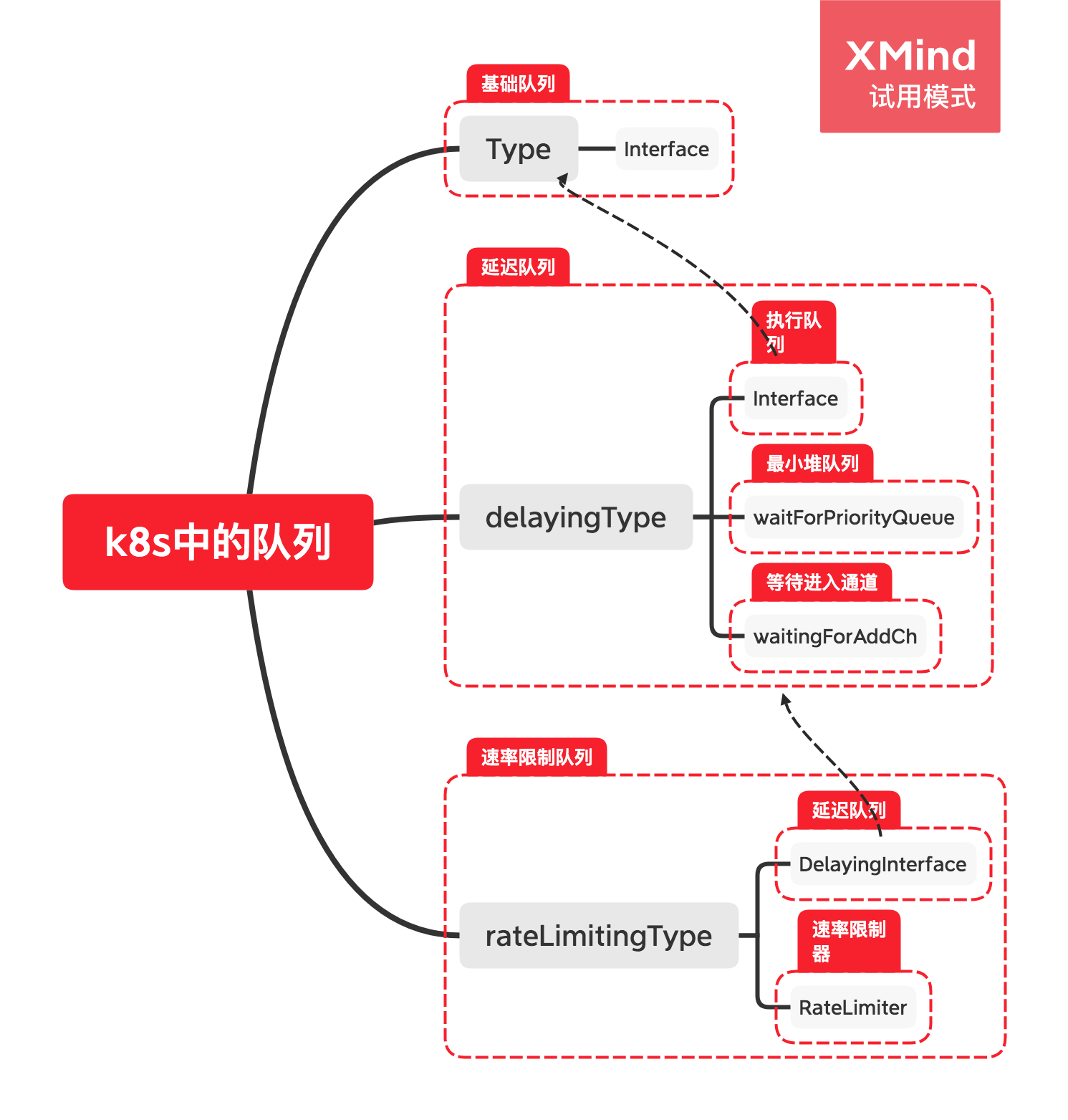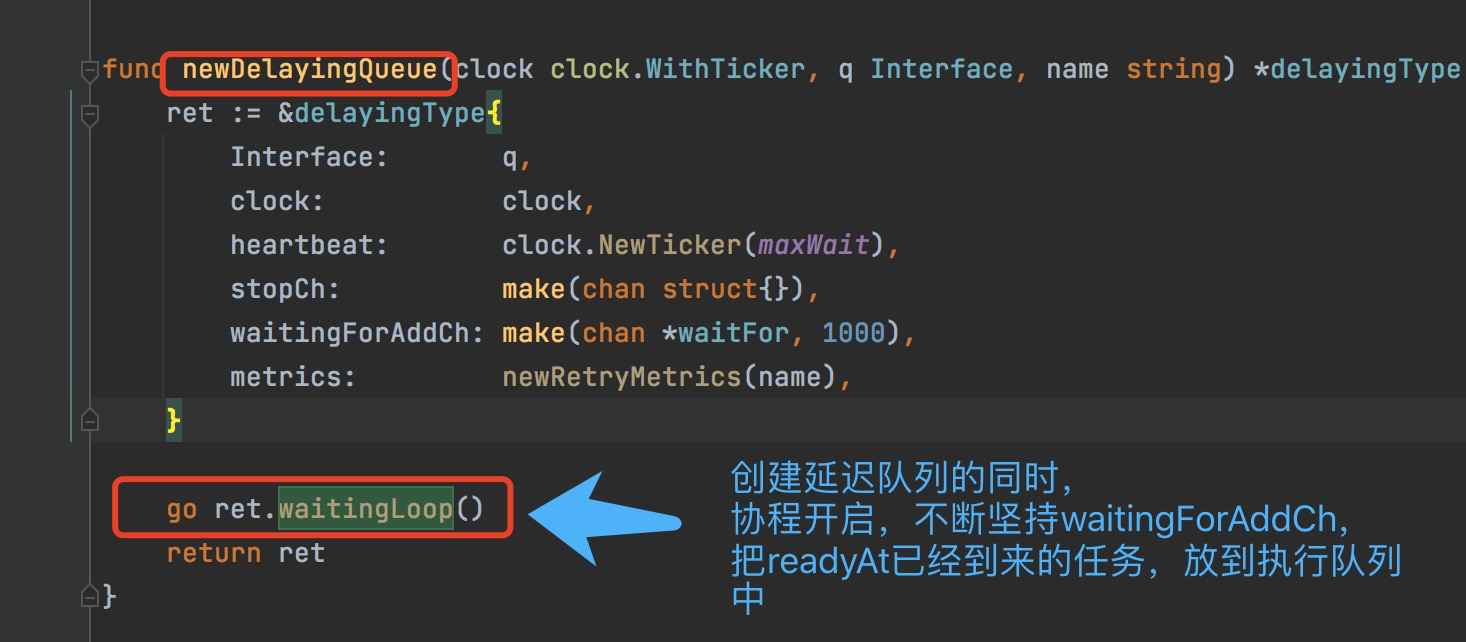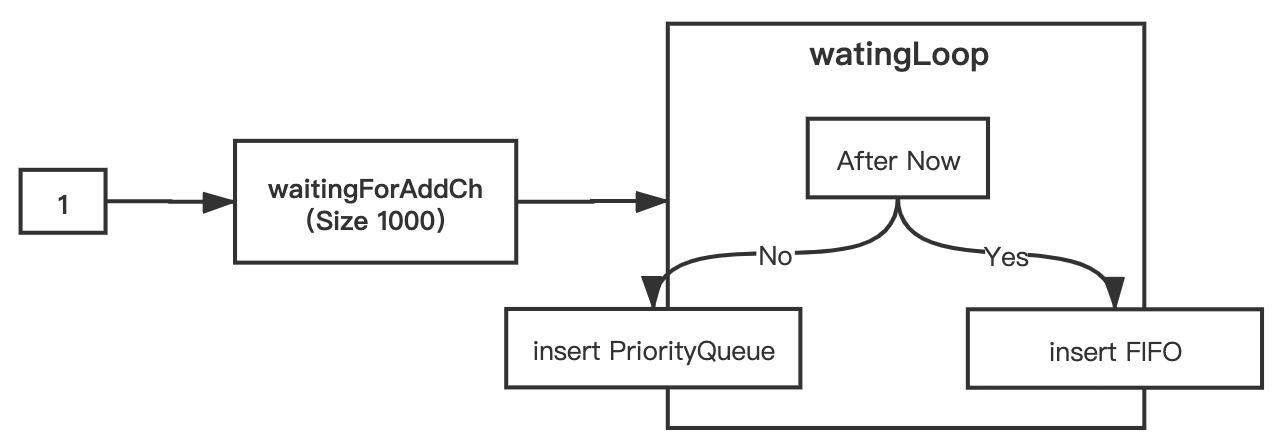
背景
我們在使用kubernetes的客戶端k8s.io/client-go 進行開發的時候,比如寫個CRD的operator, 經常會用到隊列這種數據結構。并且很多時候,我們在做服務器端后臺開發的時候,需要用到任務隊列,進行任務的異步處理與任務管理。k8s.io/client-go中的workqueue包里面提供了三種常用的隊列。今天給大家演示下三種隊列的使用方法與相應的使用場景,大家在工作中可以直接copy這些代碼,加速自己項目的開發。這三個隊列的關系如下圖所示:

k8s隊列關系
隊列
type (基礎隊列)
下面給出了數據結構,其中dirty,processing兩個集合分別存儲的是需要處理的任務和正在處理的任務,queue[]t按序存放的是所有添加的任務。這三個屬性的關系很有意思,dirty用于快速判斷queue中是否存在相應的任務,這樣有以下兩個用處:
1. 在Add的時候,可以防止重復添加。(代碼查看:?https://github.com/kubernetes/client-go/blob/master/util/workqueue/queue.go#L120?)。
2.由于在任務完成后要調用Done方法,把任務從processing集合中刪除掉,那么如果在完成前(即調用Done方法之前),把任務再次添加進dirty集合,那么在完成調用Done方法的時候,會再次把任務重新添加進queue隊列,進行處理(代碼查看:https://github.com/kubernetes/client-go/blob/master/util/workqueue/queue.go#L180)。
而processing集合存放的是當前正在執行的任務,它的作用有以下幾點。
1.在Add的時候,如果任務正在處理,就直接返回。這樣在任務調用Done的時候,由于dirty集合中有,會把這個任務再次放在隊列的尾部。(代碼查看:https://github.com/kubernetes/client-go/blob/master/util/workqueue/queue.go#L120)。
2.用于判斷隊列中是否還有任務正在執行,這樣在shutdown的時候,可以有的放矢。(代碼查看:https://github.com/kubernetes/client-go/blob/master/util/workqueue/queue.go#L221)。
整個queue隊列工作模式是,你的工作線程通過Get方法從隊列中獲取任務(如果隊列長度為0,需要q.cond.Wait()),然后處理任務(你自己的業務邏輯),處理完后調用Done方法,表明任務完成了,同時調用q.cond.Signal(),喚醒等待的工作線程?。
type Type struct {
// queue defines the order in which we will work on items. Every
// element of queue should be in the dirty set and not in the
// processing set.
queue []t
// dirty defines all of the items that need to be processed.
dirty set
// Things that are currently being processed are in the processing set.
// These things may be simultaneously in the dirty set. When we finish
// processing something and remove it from this set, we'll check if
// it's in the dirty set, and if so, add it to the queue.
processing set
cond *sync.Cond
shuttingDown bool
drain bool
metrics queueMetrics
unfinishedWorkUpdatePeriod time.Duration
clock clock.WithTicker
}delaying_queue(延遲隊列)
這個延遲隊列繼承了上面的基礎隊列,同時提供了addAfter函數,實現根據延遲時間把元素增加進延遲隊列。其中的waitForPriorityQueue實現了一個用于waitFor元素的優先級隊列,其實就是一個最小堆。
func (q *delayingType) AddAfter(item interface{}, duration time.Duration)這個函數(代碼https://github.com/kubernetes/client-go/blob/master/util/workqueue/delaying_queue.go#L162)。
當duration為0,就直接通過q.add放到它繼承的基礎執行隊列里面,如果有延遲值,就放在q.waitingForAddCh通道里面,等待readyAt時機成熟,再放到隊列中。那這個通道里面的元素當readyAt后,如何加入到基礎執行隊列?下面的截圖給出了答案,便是啟動的ret.waitingLoop協程。這個方法的具體代碼(https://github.com/kubernetes/client-go/blob/master/util/workqueue/delaying_queue.go#L189),具體思路就是利用了上面的waitForPriorityQueue最小堆,還有等待加入隊列通道q.waitingForAddCh,大家可以看看給出的具體代碼,大致的思想就會了解。

創建延遲隊列
// delayingType wraps an Interface and provides delayed re-enquing
type delayingType struct {
Interface
// clock tracks time for delayed firing
clock clock.Clock
// stopCh lets us signal a shutdown to the waiting loop
stopCh chan struct{}
// stopOnce guarantees we only signal shutdown a single time
stopOnce sync.Once
// heartbeat ensures we wait no more than maxWait before firing
heartbeat clock.Ticker
// waitingForAddCh is a buffered channel that feeds waitingForAdd
waitingForAddCh chan *waitFor
// metrics counts the number of retries
metrics retryMetrics
}
// waitFor holds the data to add and the time it should be added
type waitFor struct {
data t
readyAt time.Time
// index in the priority queue (heap)
index int
}
type waitForPriorityQueue []*waitFor

元素添加邏輯
下面是測試代碼,大家可以看看如何創建延遲隊列,還有添加任務。
下面的代碼,在延遲隊列里面增加了一個字符串"foo",延遲執行的時間是50毫秒。然后差不多50毫秒后,延遲隊列長度為0
fakeClock := testingclock.NewFakeClock(time.Now())
q := NewDelayingQueueWithCustomClock(fakeClock, "")
first := "foo"
q.AddAfter(first, 50*time.Millisecond)
if err := waitForWaitingQueueToFill(q); err != nil {
t.Fatalf("unexpected err: %v", err)
}
if q.Len() != 0 {
t.Errorf("should not have added")
}
fakeClock.Step(60 * time.Millisecond)
if err := waitForAdded(q, 1); err != nil {
t.Errorf("should have added")
}
item, _ := q.Get()
q.Done(item)
// step past the next heartbeat
fakeClock.Step(10 * time.Second)
err := wait.Poll(1*time.Millisecond, 30*time.Millisecond, func() (done bool, err error) {
if q.Len() > 0 {
return false, fmt.Errorf("added to queue")
}
return false, nil
})
if err != wait.ErrWaitTimeout {
t.Errorf("expected timeout, got: %v", err)
}
if q.Len() != 0 {
t.Errorf("should not have added")
}
func waitForAdded(q DelayingInterface, depth int) error {
return wait.Poll(1*time.Millisecond, 10*time.Second, func() (done bool, err error) {
if q.Len() == depth {
return true, nil
}
return false, nil
})
}
func waitForWaitingQueueToFill(q DelayingInterface) error {
return wait.Poll(1*time.Millisecond, 10*time.Second, func() (done bool, err error) {
if len(q.(*delayingType).waitingForAddCh) == 0 {
return true, nil
}
return false, nil
})
}
rate_limiting_queue(限速隊列)?
限速隊列是利用延遲隊列的延遲特性,延遲某個元素的插入FIFO隊列的時間,達到限速的目的
workqueue包下面的rateLimiter有多種,下面的代碼顯示的是
ItemExponentialFailureRateLimiter(排隊指數算法)。
type ItemExponentialFailureRateLimiter struct {
failuresLock sync.Mutex
failures map[interface{}]int
baseDelay time.Duration
maxDelay time.Duration
}它有個基礎延遲時間,加入到延遲隊列后,被執行的延遲時間的計算公式是如下所示。另外它還有個最大延遲時間的參數。
func (r *ItemExponentialFailureRateLimiter) When(item interface{}) time.Duration {
r.failuresLock.Lock()
defer r.failuresLock.Unlock()
exp := r.failures[item]
r.failures[item] = r.failures[item] + 1
// The backoff is capped such that 'calculated' value never overflows.
backoff := float64(r.baseDelay.Nanoseconds()) * math.Pow(2, float64(exp))
if backoff > math.MaxInt64 {
return r.maxDelay
}
calculated := time.Duration(backoff)
if calculated > r.maxDelay {
return r.maxDelay
}
return calculated
}下面的測試代碼,顯示的是創建了一個1毫秒基礎延遲,最大1秒的延遲隊列。它在延遲隊列中增加了
一個"one"字符串,由于是第一次添加,所以基于上面的公式它的延遲時間是1毫秒,再次增加"one"
后,它的延遲時間是2*1毫秒,即2毫秒,對于增加的字符串"two"也是一樣,當我們調用forget
方法后ItemExponentialFailureRateLimiter中的計數器會重置,再次增加"one"字符串后,
它的延遲時間又變成了1毫秒
limiter := NewItemExponentialFailureRateLimiter(1*time.Millisecond, 1*time.Second)
queue := NewRateLimitingQueue(limiter).(*rateLimitingType)
fakeClock := testingclock.NewFakeClock(time.Now())
delayingQueue := &delayingType{
Interface: New(),
clock: fakeClock,
heartbeat: fakeClock.NewTicker(maxWait),
stopCh: make(chan struct{}),
waitingForAddCh: make(chan *waitFor, 1000),
metrics: newRetryMetrics(""),
}
queue.DelayingInterface = delayingQueue
queue.AddRateLimited("one")
waitEntry := <-delayingQueue.waitingForAddCh
if e, a := 1*time.Millisecond, waitEntry.readyAt.Sub(fakeClock.Now()); e != a {
t.Errorf("expected %v, got %v", e, a)
}
queue.AddRateLimited("one")
waitEntry = <-delayingQueue.waitingForAddCh
if e, a := 2*time.Millisecond, waitEntry.readyAt.Sub(fakeClock.Now()); e != a {
t.Errorf("expected %v, got %v", e, a)
}
if e, a := 2, queue.NumRequeues("one"); e != a {
t.Errorf("expected %v, got %v", e, a)
}
queue.AddRateLimited("two")
waitEntry = <-delayingQueue.waitingForAddCh
if e, a := 1*time.Millisecond, waitEntry.readyAt.Sub(fakeClock.Now()); e != a {
t.Errorf("expected %v, got %v", e, a)
}
queue.AddRateLimited("two")
waitEntry = <-delayingQueue.waitingForAddCh
if e, a := 2*time.Millisecond, waitEntry.readyAt.Sub(fakeClock.Now()); e != a {
t.Errorf("expected %v, got %v", e, a)
}
queue.Forget("one")
if e, a := 0, queue.NumRequeues("one"); e != a {
t.Errorf("expected %v, got %v", e, a)
}
queue.AddRateLimited("one")
waitEntry = <-delayingQueue.waitingForAddCh
if e, a := 1*time.Millisecond, waitEntry.readyAt.Sub(fakeClock.Now()); e != a {
t.Errorf("expected %v, got %v", e, a)
}
此外這個包下面還有ItemFastSlowRateLimiter,BucketRateLimiter等。具體的大家可以查看default_rate_limiters.go(代碼:https://github.com/kubernetes/client-go/blob/master/util/workqueue/default_rate_limiters.go)。
應用場景
延遲隊列場景:
1、訂單延遲支付關閉
常見的打車軟件都會有匹配司機,這個可以用延遲隊列來實現;處理已提交訂單超過30分鐘未付款失效的訂單,延遲隊列可以很好的解決;又或者注冊了超過30天的用戶,發短信撩動等。
2、定時任務調度
比如使用DelayQueue保存當天將會執行的任務和執行時間,或是需要設置一個倒計時,倒計時結束后更新數據庫中某個表狀態
限速隊列場景:
比如限制數據隊列的寫入速度。







































